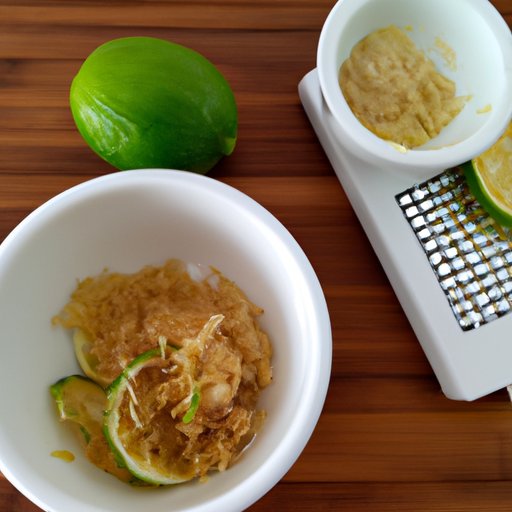
Introduction
Lime zest adds a zesty and bright flavor to many culinary applications, from desserts and cocktails to soups and curries. However, the key to achieving perfectly fragrant lime zest lies in knowing how to zest a lime properly. In this article, we will provide a comprehensive guide to zesting a lime, along with a few helpful tips and tricks. We’ll also explore the culinary uses of lime zest, the health benefits associated with consuming it, and even a tutorial on making homemade lime zest.
How to Zest a Lime
Before we dive into the specifics of zesting a lime, it’s important to understand what zest is. Lime zest is the outermost layer of the fruit’s skin, which is packed with essential oils and potent flavors. Here’s how to zest a lime in just a few simple steps:
1. First, gather your tools. You’ll need a zester, grater, or microplane. A zester is the most specific tool for this job, but a grater or microplane can also do the job.
2. Wash and dry your lime before zesting it. This will remove any dirt and debris on the skin that may affect the flavor of your zest.
3. Hold your lime securely, and then run your zester, grater, or microplane along its skin. Apply light pressure to the lime to remove only the outermost layer of the skin, without removing any of the bitter white pith underneath.
4. Once you’ve collected your zest, use it immediately or store in an airtight container for up to a week.
Tips for Choosing the Right Lime
When selecting limes for zesting, opt for those that have smooth, unblemished skin. They should feel firm to the touch, heavy for their size, and have a fresh citrus aroma. Limes that are overly ripe or have soft spots can produce zest that’s too bitter or unpleasant.
Cautionary Notes on Avoiding the Bitter White Pith
While the zest contains all the essential oils and bright flavor of the lime, the white pith beneath it is bitter and unpleasant. When zesting a lime, it’s crucial to only remove the outermost layer of skin and avoid the white pith underneath. Using a sharp zester or grater can help ensure that you collect only the vibrant zest.
Lime Zest Recipe
Now that you know how to zest a lime properly, let’s put that knowledge to work with a zesty recipe: Honey Lime Chicken.
Ingredients:
- 4 chicken breasts
- 2 limes, zest and juice
- 1/4 cup honey
- 2 tablespoons soy sauce
- 1 tablespoon olive oil
- 2 cloves garlic, finely chopped
Instructions:
1. In a small bowl, whisk together lime zest, lime juice, honey, soy sauce, olive oil, and garlic.
2. Place chicken breasts in a large resealable bag, pour in the marinade. Seal the bag and turn to coat chicken with marinade.
3. Refrigerate for at least 30 minutes or up to 24 hours.
4. Preheat grill to medium-high heat. Remove chicken from the marinade and discard the remaining marinade.
5. Grill the chicken breasts for 6-8 minutes per side or until fully cooked.
6. Serve with lime wedges and sprinkle with additional lime zest if desired.
Suggestions for Incorporating Lime Zest in Other Recipes
Lime zest is a versatile ingredient that can add a zesty brightness to many culinary applications. You can use lime zest in marinades, vinaigrettes, and salad dressings. It’s excellent in desserts such as key lime pie, sorbets, and cheesecake. Add it to cocktails or sparkling water for a refreshing twist.
Unique Ways to Use Lime Zest
Here are a few unique ways to use lime zest:
- Lime-infused simple syrup: Heat equal parts water and sugar in a saucepan until the sugar dissolves. Add lime zest, bring to a simmer, and let it steep for 30 minutes. Strain and store in a clean jar.
- Lime and herb marinade: Combine lime zest, minced garlic, olive oil, chopped fresh herbs, salt, and pepper. Use as a marinade for chicken, fish, or tofu.
- Lime zest butter: Whip together softened butter, lime zest, and a pinch of salt. Spread it on bread or use it to flavor vegetables or seafood.
Nutritional Benefits of Lime Zest
Not only does lime zest add a burst of bright flavor, but it’s also packed with health benefits. Here are a few reasons to embrace lime zest:
A Source of Antioxidants
Lime zest contains high levels of antioxidants, which protect against free radicals that can damage cells.
A Rich Source of Vitamin C
Vitamin C helps support the immune system, reduce inflammation, and promote healthy skin and nails. One tablespoon of lime zest contains around 1.5 milligrams of vitamin C, which is about two percent of your daily recommended intake.
DIY Tutorial for Homemade Lime Zest
If you don’t have a zester or grater, don’t worry — you can make homemade lime zest with just a few simple steps and materials.
1. Wash and dry your lime thoroughly.
2. Use a sharp paring knife to carefully cut away the outermost layer of the skin. Avoid the white pith underneath.
3. Once you’ve collected your zest, finely chop it or pound it with a mortar and pestle until it reaches your desired consistency.
Visual Demonstration in Video Format
For those who prefer a visual demonstration, check out this helpful video on how to zest a lime:
The video offers additional tips and tricks for using lime zest in various culinary applications, making it a great resource for novice and experienced chefs alike.
Conclusion
Now that you know how to zest a lime properly, the culinary possibilities are endless. From savory dishes to sweet treats, lime zest adds a zesty and bright flavor that’s sure to impress. Moreover, lime zest is packed with antioxidants and vitamin C, making it a healthy addition to your diet. So go ahead, zest away and explore the vibrant flavors of lime.




